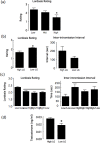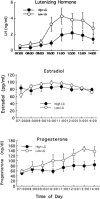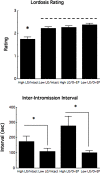Maternal programming of sexual behavior and hypothalamic-pituitary-gonadal function in the female rat
- PMID: 18493313
- PMCID: PMC2374899
- DOI: 10.1371/journal.pone.0002210
Maternal programming of sexual behavior and hypothalamic-pituitary-gonadal function in the female rat
Abstract
Variations in parental care predict the age of puberty, sexual activity in adolescence and the age at first pregnancy in humans. These findings parallel descriptions of maternal effects on phenotypic variation in reproductive function in other species. Despite the prevalence of such reports, little is known about potential biological mechanisms and this especially true for effects on female reproductive development. We examined the hypothesis that parental care might alter hypothalamic-pituitary-ovarian function and thus reproductive function in the female offspring of rat mothers that vary pup licking/grooming (LG) over the first week postpartum. As adults, the female offspring of Low LG mothers showed 1) increased sexual receptivity; 2) increased plasma levels of luteinizing hormone (LH) and progesterone at proestrus; 3) an increased positive-feedback effect of estradiol on both plasma LH levels and gonadotropin releasing-hormone (GnRH) expression in the medial preoptic region; and 4) increased estrogen receptor alpha (ERalpha) expression in the anterioventral paraventricular nucleus, a system that regulates GnRH. The results of a cross-fostering study provide evidence for a direct effect of postnatal maternal care as well as a possible prenatal influence. Indeed, we found evidence for increased fetal testosterone levels at embryonic day 20 in the female fetuses of High compared to Low LG mothers. Finally, the female offspring of Low LG mothers showed accelerated puberty compared to those of High LG mothers. These data suggest maternal effects in the rat on the development of neuroendocrine systems that regulate female sexual behaviour. Together with studies revealing a maternal effect on the maternal behavior of the female offspring, these findings suggest that maternal care can program alternative reproductive phenotypes in the rat through regionally-specific effects on ERalpha expression.
Conflict of interest statement
Figures






Similar articles
-
Perinatal testosterone exposure and maternal care effects on the female rat's development and sexual behaviour.J Neuroendocrinol. 2013 Jun;25(6):528-36. doi: 10.1111/jne.12035. J Neuroendocrinol. 2013. PMID: 23419048
-
Maternal care associated with methylation of the estrogen receptor-alpha1b promoter and estrogen receptor-alpha expression in the medial preoptic area of female offspring.Endocrinology. 2006 Jun;147(6):2909-15. doi: 10.1210/en.2005-1119. Epub 2006 Mar 2. Endocrinology. 2006. PMID: 16513834
-
Disruptions in the hypothalamic-pituitary-gonadal axis in rat offspring following prenatal maternal exposure to lipopolysaccharide.Stress. 2016;19(2):198-205. doi: 10.3109/10253890.2016.1149695. Epub 2016 Mar 3. Stress. 2016. PMID: 26941006
-
The neuroendocrinology of human puberty revisited.Horm Res. 2002;57 Suppl 2:2-14. doi: 10.1159/000058094. Horm Res. 2002. PMID: 12065920 Review.
-
Hypothalamic-pituitary-gonadal relationships in man from birth to puberty.Clin Endocrinol (Oxf). 1976 Sep;5(5):551-69. doi: 10.1111/j.1365-2265.1976.tb01985.x. Clin Endocrinol (Oxf). 1976. PMID: 791540 Review.
Cited by
-
Bi-parental care contributes to sexually dimorphic neural cell genesis in the adult mammalian brain.PLoS One. 2013 May 1;8(5):e62701. doi: 10.1371/journal.pone.0062701. Print 2013. PLoS One. 2013. PMID: 23650527 Free PMC article.
-
Can low-level ethanol exposure during pregnancy influence maternal care? An investigation using two strains of rat across two generations.Physiol Behav. 2015 Sep 1;148:111-21. doi: 10.1016/j.physbeh.2015.01.001. Epub 2015 Jan 7. Physiol Behav. 2015. PMID: 25575692 Free PMC article.
-
Epigenetic and Neurodevelopmental Perspectives on Variation in Parenting Behavior.Parent Sci Pract. 2012 Apr 1;12(2-3):202-211. doi: 10.1080/15295192.2012.683358. Epub 2012 Jun 14. Parent Sci Pract. 2012. PMID: 23162380 Free PMC article.
-
Practical solutions for including sex as a biological variable (SABV) in preclinical neuropsychopharmacological research.J Neurosci Methods. 2024 Jan 1;401:110003. doi: 10.1016/j.jneumeth.2023.110003. Epub 2023 Oct 31. J Neurosci Methods. 2024. PMID: 37918446 Free PMC article. Review.
-
Implications of temporal variation in maternal care for the prediction of neurobiological and behavioral outcomes in offspring.Behav Neurosci. 2013 Feb;127(1):33-46. doi: 10.1037/a0031219. Behav Neurosci. 2013. PMID: 23398440 Free PMC article.
References
-
- Goy RW, McEwen BS. Cambridge: MIT Press; 1980. Sexual Differentiation of the Brain.
-
- McCarthy MM. Molecular aspects of sexual differentiation of the rodent brain. Psychoneuroendocinology. 1994;19:415–427. - PubMed
-
- Breedlove SM, Hampson E. Sexual differentiation of the brain and behavior. In: Becker JB, Breedlove SM, Crews D, McCarthy MM, editors. Behavioral Endocrinology. Cambridge: MIT Press; 2002. pp. 75–114.
-
- Arnold AP. Sex chromosomes and brain gender. Nat Rev Neurosci. 2004;5:701–708. - PubMed
-
- Gross MR. Alternative reproductive strategies and tactics: diversity within sexes. Trends Ecol Evol. 1996;11:92–98. - PubMed
Publication types
MeSH terms
Substances
LinkOut - more resources
Full Text Sources
Research Materials

